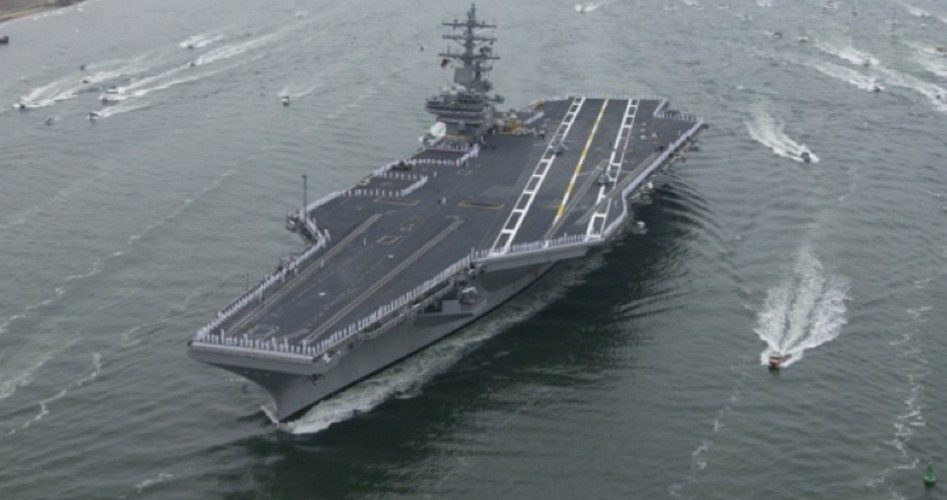
U.S. sailors are suing a Japanese utility for exposing them to nuclear radiation during a 2011 humanitarian mission to aid tsunami victims. The $1 billion lawsuit filed in a California federal court earlier this month accuses the Tokyo Electric Power Company (TEPCO) of failing to disclose the danger these U.S. Navy rescue personnel faced during Operation Tomodachi, the U.S. Department of Defense campaign undertaken from March 12 to May 11, 2011, following Japan’s devastating earthquake and tsunami. The natural disaster severely damaged the Fukushima Daiichi Nuclear Power Plant, which has since been the focus of much media hysteria over its subsequent release of radiation into the environment.
The case comes after U.S. federal judge Janis Sammartino dismissed the sailors’ initial suit late last year on jurisdictional grounds, explaining she did not have authority to determine whether the power company or the Japanese government had perpetrated fraud. (The original lawsuit included a charge of conspiracy between the government and TEPCO.) But the judge left the door open for the 51 naval personnel to refile. Their new suit includes 79 plaintiffs who allege that TEPCO officials deliberately concealed from them the risk of toxic exposure during their relief efforts, though they dropped the conspiracy charge.
Health problems the sailors have suffered since Operation Tomodachi include “leukemias, bleeding, thyroid problems, polyps, testicle removal, [and] optic nerve removal,” said California environmental law attorney Paul Garner, who represents the plaintiffs. Garner told Meghann Myers of the Navy Times, “It’s hard to imagine that all of these people are suffering now when they were all basically in their early 20s, in good health, and looking forward to life.”
But Myers also quoted Navy spokesman Lt. Greg Raelson, who explained these crew members of the nuclear-powered aircraft carrier U.S.S. Ronald Reagan (shown) did not receive hazardous doses of radiation exposure during their time on the mission. Moreover, all personnel were given medication to protect the thyroid gland (considered particularly susceptible because of its ability to absorb radioactive particles), and all ships in the fleet were constantly monitored for radioactivity.
Those readings are available to the public on the U.S. Department of Defense Environmental Health Surveillance Registries (EHSR) website. The Operation Tomodachi Registry lists 25 ships in the fleet, all of which served during the same rescue effort. Measurements for many of them are two to four times greater than those aboard the U.S.S. Ronald Reagan, the staff of which received an estimated whole-body dose of 0.008 rem and a thyroid radiation dose of 0.11 rem.
A “rem” is a measurement of biological effect of radiation exposure. For comparison’s sake, EHSR offers a chart of radiation from common sources, which includes 0.3 rem that a commercial airline crew absorbs in flight, 0.22 rem from a conventional head x-ray, and 5.0 rem delivered by a full body CT scan.
Reporting directly to sailors aboard the Ronald Reagan, EHSR told them their estimated doses were:
based on your spending 24 hours outdoors/on-deck, having a constantly high physical activity level (and associated breathing rates), and being exposed to the radiation over the entire 60-day period. Your actual radiation doses are expected to be lower due to the protection afforded by being below deck and lower levels of physical activity for much of this time.
The crew of the U.S.S. Shiloh received the most radiation during Operation Tomodachi, registering a whole-body dose of 0.033 rem and a thyroid dose of 0.31 rem. Even in that case EHSR issues the assurance to personnel that these doses “are well below levels associated with adverse medical conditions.” (Emphasis in original.) Based on its own measurements — not those of TEPCO or the Japanese government — the Navy chose not to place any personnel on “a medical surveillance program to monitor long-term health outcomes.”
This is understandable, since it takes exponentially higher doses over a much shorter time period to induce radiation sickness — e.g., nausea, vomiting, hair loss, and burn-like skin lesions. Some of the plaintiffs in this case have complained of these ongoing problems. According to The New American contributor Ed Hiserodt, “Radiation sickness ensues at about 100 rem and results from an acute exposure … over a period of several days or less. The same radiation over a longer exposure time gives no symptoms.” (The recorded Navy doses are based on the entire 60-day period of the mission.) Additionally, the U.S. Department of Veterans Affairs reports the convalescent period for patients with short-term exposure of 100 rem would average several weeks with excellent prognosis of a return to complete health.
Short-term effects aside, the seamen also blame Fukushima radiation for delayed conditions such as leukemia and other cancers. Unfortunate as their diseases are, it is unlikely that Fukushima radiation is the culprit. Information from the radiology department of the University of Washington School of Medicine explains that after exposure to radiation, the latency period, or how much time it takes cancer to develop, “is on the order of years for all cancers, with leukemia having the shortest latency period, e.g. 5-15 years, and most solid tumors having latency periods from 10-60 years.” Radiation-induced thyroid cancer takes 10 to 35 years to develop.
Furthermore, the University of Washington data show radiation levels aboard the aircraft carrier were too low to affect fetal development or outcome of pregnancy, though claimants in the current lawsuit include the two-year-old daughter of Kim Gieseking, a U.S. sailor who says she did not realize she was pregnant during the Tomodachi mission. Besides blaming TEPCO for the “degenerative disks all over in my back,” she also told the San Diego NBC affiliate she is worried her little girl may develop health problems later in life, hence her decision to sue proactively. “She seems pretty normal and healthy now,” Gieseking commented, “but that doesn’t mean that she’s not going to have something in the future.”
The Navy Times reports that Garner said about one-third of the lawsuit’s claimants remain on active duty, with one still assigned to the U.S.S. Ronald Reagan.




